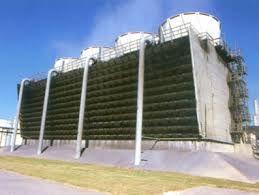 Our specialists provide cooling tower biocide water treatment. Learn why this service is essential and the applications of non-oxidizing biocide vs. oxidizing biocide.
Our specialists provide cooling tower biocide water treatment. Learn why this service is essential and the applications of non-oxidizing biocide vs. oxidizing biocide.
Cooling water provides an ideal environment for biological growth, including Legionella. Because Legionella bacteria can be a health hazard, treating your cooling water properly with the most effective biocide (bacterial disinfectant) is an extremely important task.
Using biocide in your cooling towers controls bacteria and other microbial growth. There are two main classes of biocide:
The difference is found in how the chemical attacks and kills bacteria.
Oxidizing biocide kills bacteria through the electrochemical process of oxidation, where the biocide gains an electron from the bacteria, and this electron loss essentially kills the bacteria. Oxidizing biocides are typically made up of chlorine or bromine, and these halogens are the oxidizing agents disrupting the biological cell. Oxidizers are generally most effective in systems that have high water usage. This biocide class includes chlorine, chlorine dioxide, hydrogen peroxide, bromine and ozone.
There is a wide variety of chemistry related to non-oxidizing biocide. Non-oxidizers are typically used on a prescriptive basis and introduced when there are special challenges with the water relative to the particular biological growth, the quality of the water, the pH, discharge limits/toxicity, metallurgy and chemical safety. This biocide class includes DBNPA, Isothiazoline, Glutaraldehyde and Quaternary Ammonium.
Bacteria and microorganisms cause a host of problems that require cooling tower biocide water treatment to resolve. Biocides can treat:
With the right cooling tower biocide water treatment, you can continue to run a cost-effective and energy-efficient operation.
Cooling tower biocide plans vary based on whether you use a non-oxidizing biocide or an oxidizing biocide. Oxidizing biocides destroy an organism’s cell walls almost immediately, and the protein in the cell undergoes a chemical reaction with oxygen. This process effectively kills the bacterial organism with constant feeding. Oxidizing biocide is cost-effective and fast-killing compared to non-oxidizing biocides.
In contrast, non-oxidizing biocides need a high concentration for long periods to kill bacteria. Though they are more costly than oxidizing biocides, they do not require constant feeding and remain in systems longer.
Biocides are obviously only effective if they come in contact with the bacteria within the system. Ensuring proper contact time and adequate dosage in the system is vital to keep bacteria under control in your tower.
Oxidizing biocides typically take a couple of hours of contact time at a specific dosage, while non-oxidizing biocides should remain in the system much longer. Other factors that inhibit biocide effectiveness include dead legs (areas of stagnation) in the piping, off-line pumps and filters and areas of low flow.
Deciding what biocide to use in your system is only part of what it takes to maintain a clean system. There is also a multitude of control measures that should be clearly outlined, communicated and validated in a well-constructed Water Management Plan (WMP).
Chardon can help with bacteria control. Call us today for our cooling tower water treatment services!